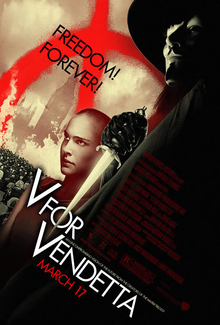| V for Vendetta | |
|---|---|
 Theatrical release poster | |
| Directed by | James McTeigue |
| Screenplay by | The Wachowskis[a] |
| Based on | V for Vendetta by David Lloyd[b] |
| Produced by |
|
| Starring | |
| Cinematography | Adrian Biddle |
| Edited by | Martin Walsh |
| Music by | Dario Marianelli |
Production companies | |
| Distributed by | Warner Bros. Pictures[1] |
Release dates |
|
Running time | 133 minutes[2] |
| Countries | |
| Language | English |
| Budget | $50–54 million[4][5] |
| Box office | $134.7 million[4] |
V for Vendetta is a 2005 dystopian political action film directed by James McTeigue (in his feature directorial debut) from a screenplay by the Wachowskis.[a] It is based on the 1988–89 DC Vertigo Comics limited series of the same title by Alan Moore, David Lloyd, and Tony Weare. The film, set in a future where a fascist totalitarian regime has subjugated the UK, centres on V (portrayed by Hugo Weaving), an anarchist and masked freedom fighter who attempts to ignite a revolution through elaborate terrorist acts, and on Evey Hammond (portrayed by Natalie Portman), a young woman caught up in V's mission. Stephen Rea portrays a detective leading a desperate quest to stop V.
Produced by Silver Pictures, Virtual Studios and Anarchos Productions, Inc., V for Vendetta was originally scheduled for release by Warner Bros. Pictures on 4 November 2005 (a day before the 400th Guy Fawkes Night), but was delayed; it instead opened in the United States on 17 March 2006, to mostly positive reviews from critics and became a box office success, grossing $134 million against a production budget between $50–54 million. Alan Moore, dissatisfied with the film adaptations of his other works, From Hell (2001) and The League of Extraordinary Gentlemen (2003), declined to watch the film and asked to not be credited or paid royalties.
Some political groups have seen V for Vendetta as an allegory of oppression by government; anarchists have used it to promote their beliefs. The film is credited for popularizing the use of the Guy Fawkes mask by anti-establishment political groups and activities; David Lloyd stated: "The Guy Fawkes mask has now become a common brand and a convenient placard to use in protest against tyranny—and I'm happy with people using it, it seems quite unique, an icon of popular culture being used this way."[6]
Cite error: There are <ref group=lower-alpha> tags or {{efn}} templates on this page, but the references will not show without a {{reflist|group=lower-alpha}} template or {{notelist}} template (see the help page).
- ^ a b "V for Vendetta". British Film Institute. Archived from the original on 19 February 2017. Retrieved 16 May 2017.
- ^ "V FOR VENDETTA (15)". British Board of Film Classification. 16 March 2006. Retrieved 2 September 2023.
- ^ "| Berlinale | Archive | Annual Archives | 2006 | Programme – V For Vendetta | V wie Vendetta". Berlinale.de. Archived from the original on 28 March 2016. Retrieved 29 March 2016.
- ^ a b Cite error: The named reference
boxofficemojowas invoked but never defined (see the help page). - ^ "V for Vendetta (2005)". The Numbers. Retrieved 29 December 2020.
- ^ Waites, Rosie (20 October 2011). "V for Vendetta masks: Who's behind them?". BBC News. Archived from the original on 14 May 2020. Retrieved 20 October 2011.